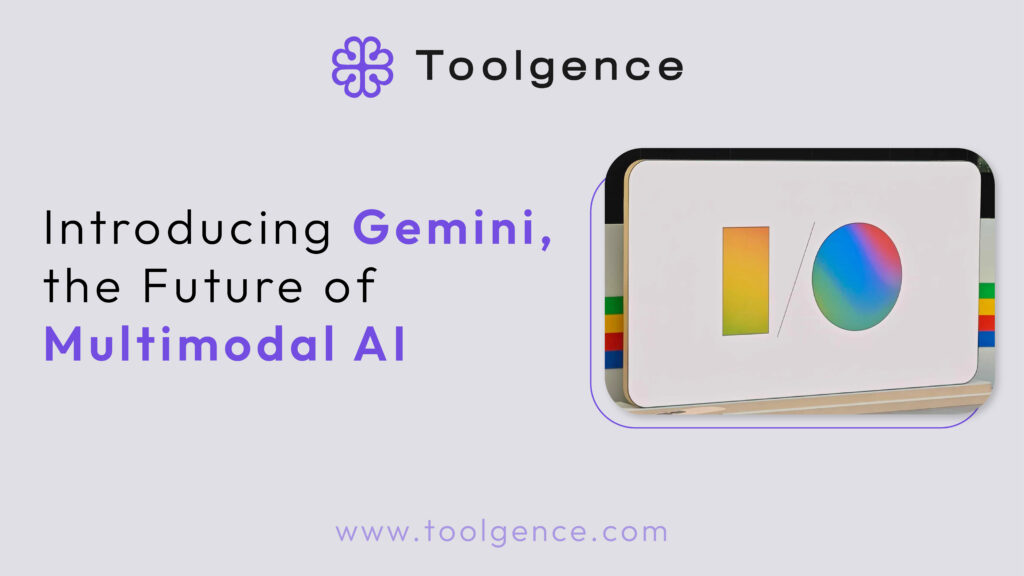
Google’s annual developer conference I/O 2024 was a clear indicator of the company’s focus on a groundbreaking frontier: multimodal artificial intelligence. The highlight of the event was Gemini Google’s latest large language model (LLM) designed to seamlessly process and integrate various data formats.
This article delves into the key takeaways from Google I/O 2024 exploring the capabilities of Gemini and its potential to revolutionize the future of AI.
Table of Contents
The Rise of Multimodal AI: Breaking Down Information Barriers
Traditionally AI models have been trained on specific data types—text-based models handle written language while image recognition models focus on visual data. This siloed approach creates limitations when dealing with the real world’s complexities where information often comes in a blend of formats.
Multimodal AI however is set to change this. Unlike its predecessors Gemini is designed to understand and process information across various modalities including:
Text:
Written content such as emails articles social media posts and code.
Images:
Photographs illustrations and other visual data.
Video:
Videos with both visual and auditory components.
Code:
Programming languages and code snippets.
By understanding these different data types Gemini can create a more comprehensive picture of the information it encounters. For instance when searching for a recipe online a traditional search engine might return text-based results. In contrast Gemini can understand the recipe instructions analyze accompanying images or videos and offer a richer more informative search experience.
Key Features of Gemini: Powering the Future of AI
Google has equipped Gemini with several key features that set it apart from previous LLMs:
1. Multimodal Understanding
Gemini can process information across various formats allowing it to grasp the nuances of how different data types interact with each other.
2. Long Context Integration
One of the challenges with traditional LLMs is their limited context window. Gemini addresses this by effectively integrating information from a larger context enabling it to understand complex topics and generate more comprehensive responses.
3. Accessibility for Developers
Google is committed to making this powerful technology accessible. The company is releasing various tools and APIs that allow developers to integrate Gemini’s capabilities into their applications.
The Impact of Gemini: A Multifaceted Approach
The implications of Gemini extend far beyond developer tools. Google plans to integrate this technology into its existing products and services in several ways:
Enhanced Search
Search results will become more relevant and informative as Gemini can analyze various data types to better understand user queries. For example when searching for travel destinations users might not only get text-based results but also see immersive videos and photos that enhance the travel planning experience.
Revolutionizing Photos and Workspace
Google Photos could leverage Gemini’s multimodal understanding to automatically categorize and organize photos based on their content not just filenames or timestamps. Additionally Google Workspace (formerly G Suite) could benefit from features like real-time translation across different languages within documents or presentations.
Deep Dive into the Gemini Family
Google DeepMind has developed a family of AI models under the name Gemini each designed for specific use cases and purposes. Here’s a closer look at some of the prominent members of the Gemini family:
Gemini Ultra
The largest and most powerful model in the Gemini family Gemini Ultra excels at complex tasks like code generation and reasoning. [More details](https://deepmind.google/technologies/gemini/)
Gemini Pro
This model strikes a balance between performance and efficiency capable of handling a wide range of tasks across text image audio and video formats. [More details](https://deepmind.google/technologies/gemini/pro/)
Gemini Flash
Designed for speed and cost-effectiveness Gemini Flash can process large amounts of data making it suitable for tasks like video and audio analysis. [More details](https://deepmind.google/technologies/gemini/flash/)
Gemini Nano
The most efficient model in the family Gemini Nano is optimized for on-device use and capable of tasks like text summarization speech recognition and image description. [More details](https://deepmind.google/technologies/gemini/nano/)
Conclusion: A New Chapter in Human-Machine Interaction
Google I/O 2024 marked a significant turning point in artificial intelligence. With the introduction of Gemini Google is paving the way for a future where AI can understand and interact with the world in a more holistic a nd intuitive manner. This leap in technology promises to enhance how we search work and engage with digital content ushering in a new era of human-machine interaction.
